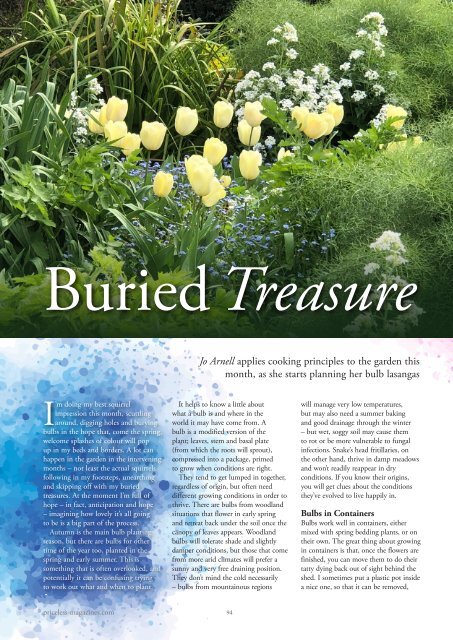Surrey Homes | SH105 | October 2023 | Interiors & Bathrooms Supplement inside
The lifestyle magazine for Surrey - Inspirational Interiors, Fabulous Fashion, Delicious Dishes
The lifestyle magazine for Surrey - Inspirational Interiors, Fabulous Fashion, Delicious Dishes
Create successful ePaper yourself
Turn your PDF publications into a flip-book with our unique Google optimized e-Paper software.
Buried Treasure<br />
Jo Arnell applies cooking principles to the garden this<br />
month, as she starts planning her bulb lasangas<br />
I’m doing my best squirrel<br />
impression this month, scuttling<br />
around, digging holes and burying<br />
bulbs in the hope that, come the spring,<br />
welcome splashes of colour will pop<br />
up in my beds and borders. A lot can<br />
happen in the garden in the intervening<br />
months – not least the actual squirrels<br />
following in my footsteps, unearthing<br />
and skipping off with my buried<br />
treasures. At the moment I’m full of<br />
hope – in fact, anticipation and hope<br />
– imagining how lovely it’s all going<br />
to be is a big part of the process.<br />
Autumn is the main bulb planting<br />
season, but there are bulbs for other<br />
time of the year too, planted in the<br />
spring and early summer. This is<br />
something that is often overlooked, and<br />
potentially it can be confusing trying<br />
to work out what and when to plant.<br />
It helps to know a little about<br />
what a bulb is and where in the<br />
world it may have come from. A<br />
bulb is a modified version of the<br />
plant; leaves, stem and basal plate<br />
(from which the roots will sprout),<br />
compressed into a package, primed<br />
to grow when conditions are right.<br />
They tend to get lumped in together,<br />
regardless of origin, but often need<br />
different growing conditions in order to<br />
thrive. There are bulbs from woodland<br />
situations that flower in early spring<br />
and retreat back under the soil once the<br />
canopy of leaves appears. Woodland<br />
bulbs will tolerate shade and slightly<br />
damper conditions, but those that come<br />
from more arid climates will prefer a<br />
sunny and very free draining position.<br />
They don’t mind the cold necessarily<br />
– bulbs from mountainous regions<br />
will manage very low temperatures,<br />
but may also need a summer baking<br />
and good drainage through the winter<br />
– but wet, soggy soil may cause them<br />
to rot or be more vulnerable to fungal<br />
infections. Snake’s head fritillaries, on<br />
the other hand, thrive in damp meadows<br />
and won’t readily reappear in dry<br />
conditions. If you know their origins,<br />
you will get clues about the conditions<br />
they’ve evolved to live happily in.<br />
Bulbs in Containers<br />
Bulbs work well in containers, either<br />
mixed with spring bedding plants, or on<br />
their own. The great thing about growing<br />
in containers is that, once the flowers are<br />
finished, you can move them to do their<br />
tatty dying back out of sight behind the<br />
shed. I sometimes put a plastic pot <strong>inside</strong><br />
a nice one, so that it can be removed,<br />
priceless-magazines.com 94


















